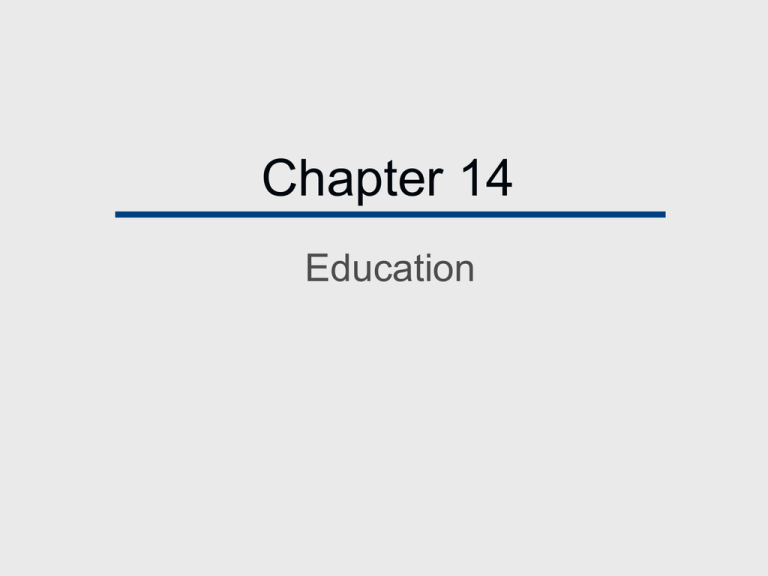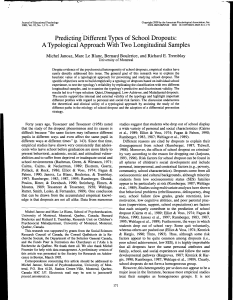Chapter 14 Education
advertisement

Chapter 14 Education Chapter Outline Education: A Functionalist View The Conflict Theory View Issues in American Education Cultural Transmission Passing major portions of society’s knowledge from one generation to the next. Schools are a major means of cultural transmission. Our society contains many cultural differences, and conflicting ideas on what should be taught in schools. Question Which of the following is a latent function of education? A. providing child care B. teaching basic academic skills C. transmitting cultural knowledge D. generating innovation Answer: A Providing child care is a latent function of education. Education America Act, 1994 Eight Educational Goals 1. 2. 3. 4. All children should enter school ready to learn. The U.S. high-school graduation rate should reach 90%. U.S. students should lead the world in math and science performance. Every adult should be competent as a citizen and a worker. Education America Act, 1994 Eight Educational Goals 5. 6. 7. 8. Schools should be free of drugs and violence. Students should demonstrate academic competencies in specific areas as they progress through school. Parents should become more involved in their children’s education. Teachers should expand and perfect their professional skills throughout their careers. No Child Left Behind Act, 2002 Changed the federal government's role in education. Four principles: stronger accountability for results increased flexibility and local control expanded options for parents emphasis on proven teaching methods College Students and the Internet 20% of today’s college students started using the Internet between the ages of 5 and 8. 72% check e-mail at least once a day. 66% have at least two e-mail addresses. 26% use instant messaging on any given day. 85% own their own computers. 60% have downloaded music files. College Students and the Internet 46% believe e-mail makes it possible for them to express ideas to a professor they would not express in class. 73% say they use the Internet more than the library for research. 37% of precollege students said “too many” students use the Internet to cheat. Child Care A latent function of public schools is to provide child care. As of 2000, 77.2% of married women with school age children were in the labor force. Women with children worked more hours each week on average in 2000 than they did in 1969. School Lunch Programs 1975: Number of students in the federally funded school lunch programs was 25,289,000, at a cost of $1.28 billion. 1999: More than 27 million children got their lunch through the school lunch program at a cost of $5.46 billion. % of Adults Age 25–29 Who Have a Bachelor’s Degree % of People With a College Degree— Ages 25 to 34 Country Canada France Germany Italy Japan United Kingdom United States Men 18% 11.9 12.7 7.7 34.2 Women 18.9% 11.3 11 8.1 11.5 15.7 11.7 23.4 23.5 Question How far do you intend to go in school? A. Two years of college B. Four years of college C. Master's degree D. Professional degree (law, medicine, dentistry) E. Ph.D. The Conflict Theory View Schools stifle individualism and creativity in the name of maintaining order. The educational system socializes students into values dictated by the powerful majority. Screening and Allocation: Tracking Tracking begins with placing students in “fast,” “average,” and “slow” groups in the 1st grade. Teachers expect a certain level of performance from the student based on their group. Students sense this expectation and will often give the level of performance that is expected. Question Rate yourself on academic ability compared with the average person your age. A. Highest 10 percent B. Above average C. Average D. Below average E. Bottom 10 percent High-School Dropouts Factors associated with drop outs: Low educational and occupational attainment levels of parents Low family income Speaking a language other than English in the home Single-parent families Poor academic achievement Dropping Out: Effects on Society Dropouts pay less in taxes, because of their lower earnings. Dropouts increase the demand for social services including welfare, medical assistance, and unemployment compensation. Dropouts are less likely to vote. Dropouts have poorer health. Half of all state prison inmates were drop outs. Median Income By Education Level Average SAT Scores, 1995– 2005 The Gifted Ellen Winner (1996) has proposed that gifted children have three atypical traits: precociousness— gifted children begin early to master some domain nonconformity, an insistence on doing things according to their own specific rules a rage to master, or a desire to know everything there is to know about a subject.





